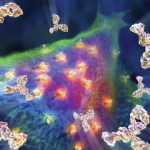
Dr. Fox
David Fox, MD, a professor of rheumatology at the University of Michigan, Ann Arbor, says, “I think the key paper that really explained what was going on was this Journal of Clinical Investigation paper in 1998 from van Venrooij’s group.”8
This team from The Netherlands made a breakthrough in solving the mystery and identifying the antigenic target. They demonstrated that the amino acid citrulline was an essential part of the antigens recognized by the anti-filaggrin autoantibodies. They also figured out that there was a post-translational modification of arginine to citrulline, explaining why the autoantibodies were not picked up in non-fully differentiated filaggrin or in recombinant filaggrin.8
Therefore, this antibody group could be more properly categorized as anti-citrullinated peptide/protein antibodies. Adds Dr. Fox, “This paper showed indeed that it was citrullination that was generating not just one autoantigen, but a group of autoantigens that these antibodies could recognize.” It was eventually found that a wide array of citrullinated proteins are recognized by these autoantibodies.
Citrullination
Citrullination refers to a post-translational modification that can be performed on a number of different proteins, including histones, vimentin, fibrinogen, filaggrin and type II collagen. The enzyme peptidyl arginine deiminase (PAD) modifies the genomic amino acid arginine to citrulline—an amino acid not specifically encoded in the genome, but which is only created as a post-translational modification.9 Citrullination is now thought to be essential for many important biological processes, including the formation and release of some types of neutrophil extracellular traps (NETs) by neutrophils. In tissue marked by inflammation, the process of citrullination is now known to be widespread.4
Dr. Holers explains that citrullination is one of the processes that appears to be fundamental to inflammation, as well as to many intracellular immune regulatory processes that continue to be identified. He also notes this process often changes the function of the citrullinated protein.
“With neutrophils, it’s believed that citrullination of histones allows chromatin to unwind to allow certain types of NETs to be formed,” he says. “In skin keratinocyte differentiation, it is thought to be necessary for filaggrin to be processed. Citrullination can also help to control gene regulation, and thus it is thought to be an epigenetic modifier of gene function.”
It is currently believed that under physiologically normal conditions, the immune system only rarely encounters citrullinated proteins, which are usually intracellular. Citrullination is a normal process in many dying cells, however. These may then release citrullinated proteins into the extracellular matrix, or they may release PAD itself, which may continue to citrullinate various extracellular proteins.7
Citrullination itself is thought to augment inflammation, although the situation is complex and not yet well characterized. Though citrullination is found in inflamed tissue in many different inflammatory diseases, ACPAs are highly specific for rheumatoid arthritis.4

